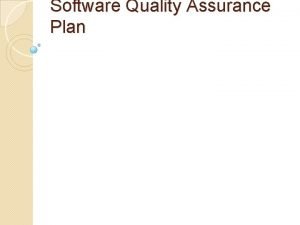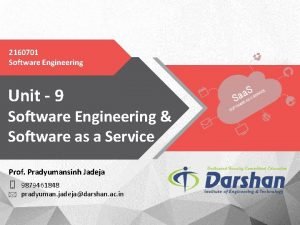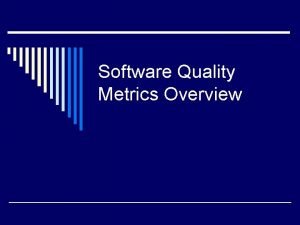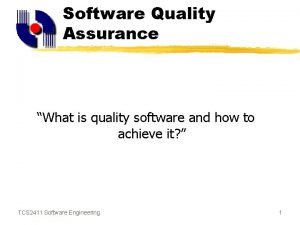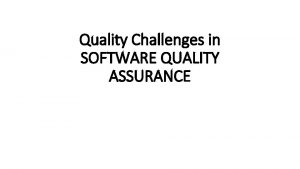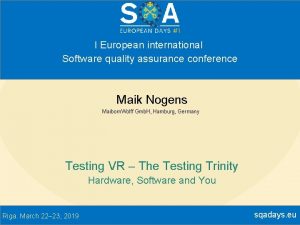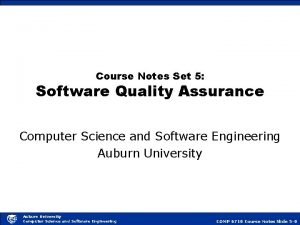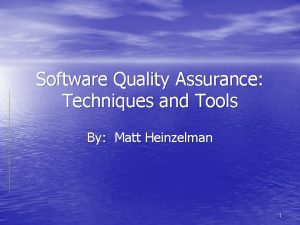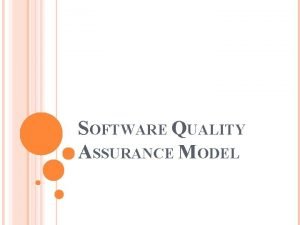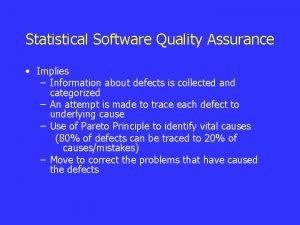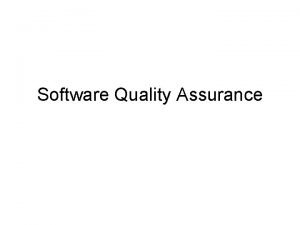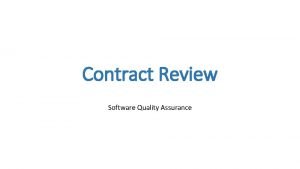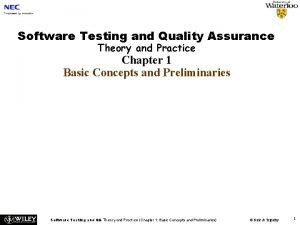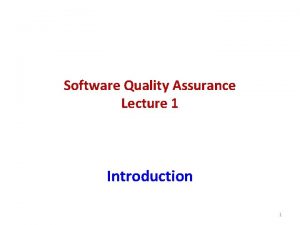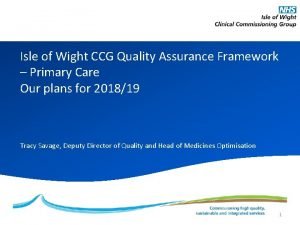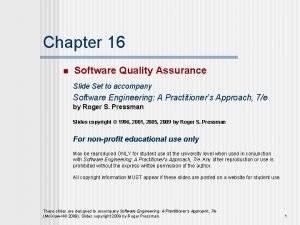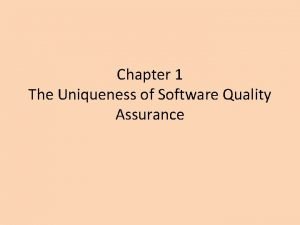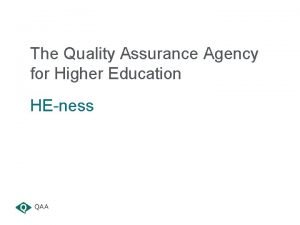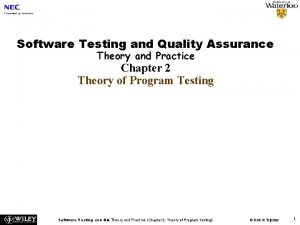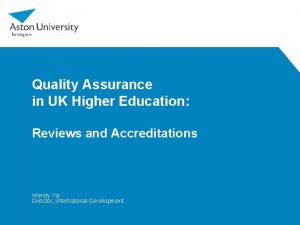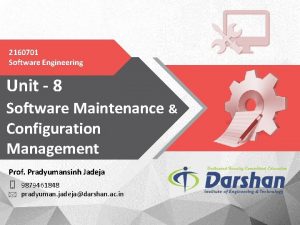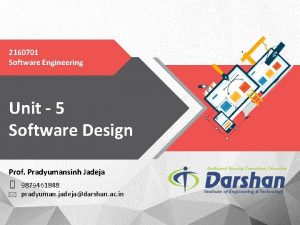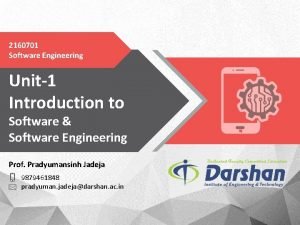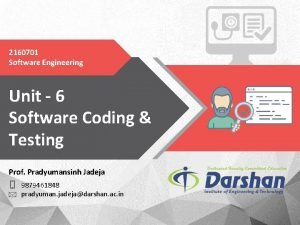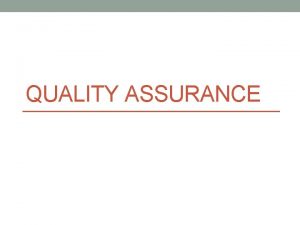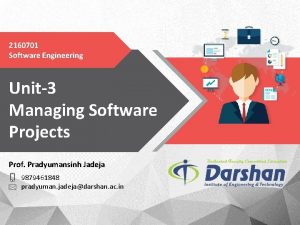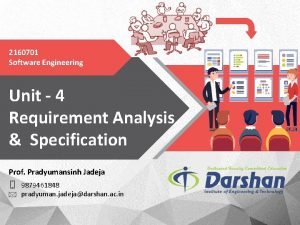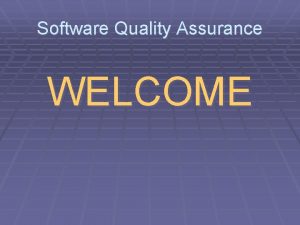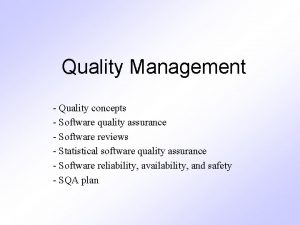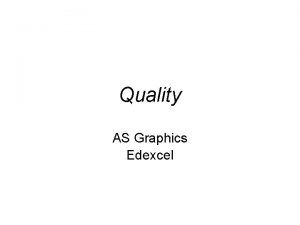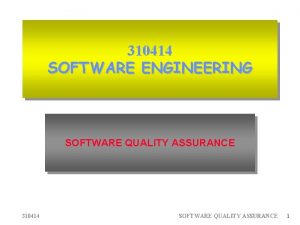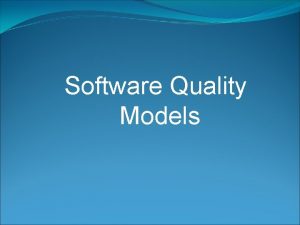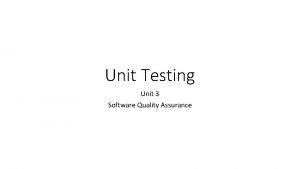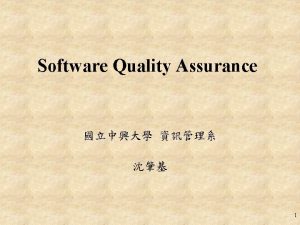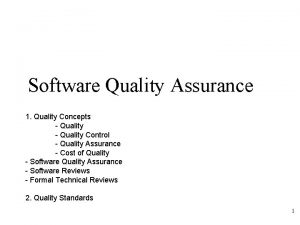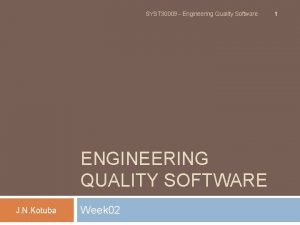2160701 Software Engineering Unit 7 Quality Assurance Management




























- Slides: 28

2160701 Software Engineering Unit - 7 Quality Assurance & Management Prof. Pradyumansinh Jadeja 9879461848 pradyuman. jadeja@darshan. ac. in

Outlines § § Quality Concepts and Software Quality Assurance Software Reviews (Formal Technical Reviews) Software Reliability The Quality Standards • ISO 9000 • CMM • Six Sigma for SE • SQA Plan Unit – 7: Quality Assurance & Mgmt. 2 Darshan Institute of Engineering & Technology

What is Quality – developed product meets it’s specification Quality Management Ensuring that required level of product quality is achieved • • Defining procedures and standards Applying procedures and standards to the product and process Checking that procedures are followed Collecting and analyzing various quality data Unit – 7: Quality Assurance & Mgmt. 3 Darshan Institute of Engineering & Technology

Software Quality Assurance (SQA) § Software quality assurance (also called quality management) is an umbrella activity that is applied throughout the software process § It is planned and systematic pattern of activities necessary to provide high degree of confidence in the quality § Software quality assurance (SQA) encompasses • An SQA process • Specific quality assurance and quality control tasks • Effective software engineering practice • Control of all software work products • A procedure to ensure compliance with software development standards • Measurement and reporting mechanisms Unit – 7: Quality Assurance & Mgmt. 4 Darshan Institute of Engineering & Technology

SQA Activities § Prepare an SQA plan for a project § Participate in the development of the project’s software process description § Review software engineering activities to verify compliance with the defined software process § Audit designated software work products to verify compliance with those defined as part of the software process § Ensure that deviations in software work and work products are documented and handled according to a documented procedure § Records any noncompliance and reporting to senior management Unit – 7: Quality Assurance & Mgmt. 5 Darshan Institute of Engineering & Technology

SQA Techniques § Statistical quality assurance implies the following steps: 1. Information about software defects is collected and categorized 2. An attempt is made to trace each defect to its underlying cause o Ex. , non-conformance to specifications, design error, violation of standards, poor communication with the customer 3. Using the Pareto principle (80 percent of the defects can be traced to 20 percent of all possible causes), isolate the 20 percent (the "vital few"). 4. Once the vital few causes have been identified, move to correct the problems that have caused the defects. § Some of the defects are uncovered as software is being developed. § Other are encountered after the software has been released. Unit – 7: Quality Assurance & Mgmt. 6 Darshan Institute of Engineering & Technology

SQA Techniques (Cont. ) Uncovered errors can be tracked to (one or more) of the following causes • • • Incomplete or erroneous specifications (IES) Misinterpretation of customer communication (MCC) Intentional deviation from specifications (IDS) Violation of programming standards (VPS) Error in data representation (EDR) Inconsistent component interface (ICI) Error in design logic (EDL) Incomplete or erroneous testing (IET) Inaccurate or incomplete documentation (IID) Error in programming language translation of design (PLT) Ambiguous or inconsistent human/computer interface (HCI) Miscellaneous (MIS) Unit – 7: Quality Assurance & Mgmt. 7 Darshan Institute of Engineering & Technology

Software Reviews (Formal Technical Reviews) § A formal technical review (FTR) is a software quality control activity performed by software engineers (and others) § The objectives of an FTR are: 1. To uncover errors in function, logic, or implementation; for any 2. 3. 4. 5. representation of the software To verify that the software under review meets its requirements To ensure that the software has been represented according to predefined standards To achieve software that is developed in a uniform manner To make projects more manageable Unit – 7: Quality Assurance & Mgmt. 8 Darshan Institute of Engineering & Technology

Review Reporting & Record Keeping § During the FTR, • a reviewer (the recorder) actively records all issues that have been raised § These are summarized at the end of the review meeting, and a reviewed issues list is produced § In addition, a formal technical review summary report is completed Unit – 7: Quality Assurance & Mgmt. 9 Darshan Institute of Engineering & Technology

Review Guidelines for conducting formal technical reviews must be established in advance, distributed to all reviewers, agreed upon & then followed Review the product, not the producer Set an agenda and maintain it Limit debate and denial Speak problem areas, but don't attempt to solve every problem noted Take written notes Conduct meaningful training for all reviewers Limit the number of participants and insist upon advance preparation Develop a checklist for each product that is likely to be reviewed Allocate resources and schedule time for FTRs Unit – 7: Quality Assurance & Mgmt. 10 Review your early reviews Darshan Institute of Engineering & Technology

Differentiation of SQA & SQC Differentiation Software Quality Assurance (SQA) - Software Quality Control (SQC) SQA Criteria SQC Definition SQA is a set of activities for ensuring quality in software engineering processes (that ultimately result in quality in software products). The activities establish and evaluate the processes that produce products SQC is a set of activities for ensuring quality in software products. The activities focus on identifying defects in the actual products produced Focus Process focused Product focused Orientation Prevention oriented Detection oriented Breadth Organization wide Product/project specific Scope Relates to all products that will ever be created by a process Relates to specific product Activities Process Definition and Implementation, Audits, Training Reviews, Testing Unit – 7: Quality Assurance & Mgmt. 11 Darshan Institute of Engineering & Technology

Software Reliability Software reliability is defined in statistical terms as The probability of failure-free operation of a computer program in a specified environment for a specified time A simple measure of reliability is meantime-between-failure (MTBF): MTBF = MTTF + MTTR MTTF = mean-time-to-failure MTTR = mean-time-to-repair Unit – 7: Quality Assurance & Mgmt. 12 Darshan Institute of Engineering & Technology

Measures of Reliability § Many researchers argue that MTBF is a far more useful measure than other quality-related software metrics § An end user is concerned with failures, not with the total defect count § Because each defect contained within a program does not have the same failure rate, the total defect count provides little indication of the reliability of a system § An alternative measure of reliability is failures-in-time (FIT) • a statistical measure of how many failures a component will have over one billion hours of operation Unit – 7: Quality Assurance & Mgmt. 13 Darshan Institute of Engineering & Technology

Software Safety § Software safety is a software quality assurance activity • that focuses on the identification and assessment of potential hazards that may affect software negatively and cause an entire system to fail § If hazards can be identified early in the software process, • software design features can be specified that will either eliminate or control potential hazards § A modelling and analysis process is conducted as part of software safety § Initially, hazards are identified and categorized by criticality and risk Unit – 7: Quality Assurance & Mgmt. 14 Darshan Institute of Engineering & Technology

Software Safety Cont. § Although software reliability and software safety are closely related to one another, it is important to understand the subtle difference between them • Software reliability uses statistical analysis to determine the likelihood that a software failure will occur • However, the occurrence of a failure does not necessarily result in a hazard or accident • Software safety examines the ways in which failures can lead to an accident Unit – 7: Quality Assurance & Mgmt. 15 Darshan Institute of Engineering & Technology

The quality standards ISO 9000 and 9001, Six Sigma, CMM

ISO 9001 § In order to bring quality in product and service, many organizations are adopting Quality Assurance System § ISO standards are issued by the International Organization for Standardization (ISO) in Switzerland § Proper documentation is an important part of an ISO 9001 Quality Management System. § ISO 9001 is the quality assurance standard that applies to software engineering § It includes, requirements that must be present for an effective quality assurance system § ISO 9001 standard is applicable to all engineering discipline Unit – 7: Quality Assurance & Mgmt. 17 Darshan Institute of Engineering & Technology

ISO 9001 Cont. The requirements described by ISO 9001: 2000 address topics such as Management Responsibility Quality System Contract Review Design Control Document Data Control Product Identification Traceability Process Control Inspection Testing Preventive Action Control of Quality Records Internal Quality Audits Training Servicing In order for a software organization to become registered to ISO 9001: 2000 1. It must establish policies and procedures to address each of the requirements just noted 2. Able to demonstrate that these policies and procedures are being followed Unit – 7: Quality Assurance & Mgmt. 18 Darshan Institute of Engineering & Technology

Six Sigma § Six sigma is “A generic quantitative approach to improvement that applies to any process” § Six Sigma is a disciplined, data-driven approach and methodology for eliminating defects in any process - from manufacturing to transactional and from product to service § To achieve six sigma, a process must not produce more than 3. 4 defects per million opportunities • 4 Sigma 6210 defects per million opportunities • 5 Sigma 230 defects per million opportunities § Six sigma have two methodologies. • DMAIC (Define, Measure, Analyze, Improve, Control) • DMADV (Define, Measure, Analyze, Design, Verify) Unit – 7: Quality Assurance & Mgmt. 19 Darshan Institute of Engineering & Technology

DMAIC - Six Sigma Define: Define the problem or process to improve upon related to the customer and goals Measure: How can you measure this process in a systematic way? Analyze: Analyze the process or problem and identify the way in which it can be improved. What are the root causes of problems within the process? Improve: Once you know the causes of the problems, present solutions for them and implement them. Control: Utilize Statistical Process Control to continuously measure your results and ensure you are improving Several Software Packages available to assist in measuring yield, defects per million opportunities, etc. Unit – 7: Quality Assurance & Mgmt. 20 Darshan Institute of Engineering & Technology

DMADV - Six Sigma Define, Measure and analyze are similar to above method Design: Avoid root causes of defects and meet the customer requirements Verify: To verify the process, compare the process with the standard plan and find differences Unit – 7: Quality Assurance & Mgmt. 21 Darshan Institute of Engineering & Technology

Example of Six Sigma Company Mumbai's Dabbawalas For over 100 years they have delivered food to every part of the city, earning them a Six Sigma rating (a Forbes rating of 99. 9 % which means one error in 6 million transactions). Unit – 7: Quality Assurance & Mgmt. 22 Darshan Institute of Engineering & Technology

CMM (Capability Maturity Model) § To determine an organization’s current state of process maturity, the SEI (Software Engineering Institute) uses an assessment that results in a five point grading scheme § The grading scheme determines compliance with a capability maturity model (CMM) that defines key activities required at different levels of process maturity The SEI approach establishes five process maturity levels that are defined in the following manner Level 1: Initial • The software process is characterized as ad hoc and occasionally • Few processes are defined and success depends on individual effort Unit – 7: Quality Assurance & Mgmt. 23 Darshan Institute of Engineering & Technology

CMM (Capability Maturity Model) Level 2: Repeatable • Basic project management processes are established to track cost, schedule, and functionality. • The necessary process discipline is in place to repeat earlier successes on Project Level 3: Defined • The software process for both management and engineering activities is documented, standardized and integrated • This level includes all characteristics defined for level 2 Level 4: Managed • Detailed measures of the software process and product quality are collected • This level includes all characteristics defined for level 3 Unit – 7: Quality Assurance & Mgmt. 24 Darshan Institute of Engineering & Technology

CMM (Capability Maturity Model) Level 5: Optimizing • Continuous process improvement is enabled by quantitative feedback from the process and from testing innovative ideas and technologies • This level includes all characteristics defined for level 4 Unit – 7: Quality Assurance & Mgmt. 25 Darshan Institute of Engineering & Technology

SQA Plan § The SQA Plan provides a road map for establishing software quality assurance § The plan serves as a template for SQA activities that are instituted for each software project § The standard recommends a structure that identifies: • The purpose and scope of the plan • A description of all software engineering work products (e. g. , models, documents, source code). • All applicable standards that are applied during the software process • SQA actions and their placement throughout the software process • The tools and methods that support SQA actions and tasks Unit – 7: Quality Assurance & Mgmt. 26 Darshan Institute of Engineering & Technology

SQA Plan Cont. • Software configuration management procedures • Methods for assembling, safeguarding and maintaining all SQArelated records • Organizational roles and responsibilities relative to product quality Unit – 7: Quality Assurance & Mgmt. 27 Darshan Institute of Engineering & Technology

Summary SQA Importance of SQA Activities SQA Techniques Software Reviews (Formal Technical Reviews) Software Reliability Software Safety The Quality Standards • ISO 9000 • CMM • Six Sigma for SE § SQA Plan § § § § Unit – 7: Quality Assurance & Mgmt. 28 Darshan Institute of Engineering & Technology
 Statistical quality assurance in software engineering
Statistical quality assurance in software engineering Software quality assurance plan documentation
Software quality assurance plan documentation 2160701
2160701 2160701
2160701 Quality assurance vs quality control
Quality assurance vs quality control Plan quality management pmp
Plan quality management pmp Pmp gold plating
Pmp gold plating Process of nursing audit
Process of nursing audit Quality improvement vs quality assurance
Quality improvement vs quality assurance Quality control concepts
Quality control concepts Types of software metrics
Types of software metrics Iso 9001 software quality assurance
Iso 9001 software quality assurance Software quality assurance challenges
Software quality assurance challenges Maiborn wolff
Maiborn wolff Software quality assurance notes
Software quality assurance notes Software testing and quality assurance theory and practice
Software testing and quality assurance theory and practice Software quality assurance tools and techniques
Software quality assurance tools and techniques Software quality assurance models
Software quality assurance models Statistical software quality assurance
Statistical software quality assurance Defect amplification and removal in software engineering
Defect amplification and removal in software engineering #1 contract review software
#1 contract review software The quality revolution
The quality revolution Introduction to software quality assurance
Introduction to software quality assurance The isle quality assurance
The isle quality assurance Software quality assurance slideshare
Software quality assurance slideshare Uniqueness of software quality assurance
Uniqueness of software quality assurance Software quality assurance agency
Software quality assurance agency Software testing and quality assurance theory and practice
Software testing and quality assurance theory and practice Software quality assurance agency uk
Software quality assurance agency uk

